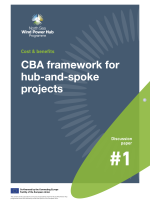Future-proof energy system in a cost-effective way
One exciting aspect of the build-out in the North Sea, aside from the ambitious scale, is all the new building bricks. New technologies and new physical structures will go into the design in a way we don’t have anywhere in the world today.
It’s important to pick the right approach with all the right bricks. The most intuitive approach is also the simplest: connect future offshore wind farms to shore with a direct connection to the specific windfarm’s home country. But in this case, simplicity is not a virtue: efficiency is.
The challenge
When building the future green power plant in the North Sea, we need to choose the most promising design principle in order to avoid costly mistakes further down the road, and to allow us to move ahead with the build-out and reach the climate goals. Making the right choices requires a new approach to cost-benefit analysis.
One very promising design principle, called hub- and-spoke, means introducing a whole new brick: the energy hub. A hub is where offshore wind energy is accumulated. From here, cables run to shore, and interconnectors run between hubs to distribute energy over multiple countries. The hubs will make sure the North Sea is one giant green power plant, able to supply many energy markets, rather than many smaller plants tied to specific countries. The hubs will make sure the energy goes where it is needed the most. This does not mean that everything will be connected to everything else. The right balance must be struck by making the optimal connections to tie countries together in a cost- effective way.
How this is best done is in no way obvious. Large infrastructure projects require a cost-benefit analysis based on a solid methodology. Mistakes can be costly. It has been necessary to develop a new approach to the analysis of large-scale offshore wind projects in order to match the innovative nature of what lies ahead. The consortium has successfully tested a new framework for hub-and-spoke projects across sectors, both onshore and offshore and internationally. We now have a credible answer to the question of how best to design the future energy system.
The insight
The true heroes of the wind story will be the offshore hubs. They will make offshore wind at massive scale truly cost competitive towards 2050 and will enable us to harvest the full potential of the North Sea compared to an alternative tied to national borders. This new insight, based on a whole new methodology for cost-benefit analysis, allows us to move ahead with the build-out today.
The hub-and-spoke design will have other advantages than cost effectiveness. They will increase international coordination in production and distribution. They can potentially reduce the build-out of capacity needed for transporting energy, which is no small investment in and of itself. They could allow for fewer landing zones onshore and mean less need to build infrastructure where people live.
If we choose hub-and-spoke as the design principle, we can expect positive economic benefits. Exact numbers are uncertain and depend on available alternatives, but overall the analysis shows it to be cost-competitive as well as future-proof. The hub- and-spoke concept is also easy to fit with current national plans for offshore wind as they are decided.
More information


